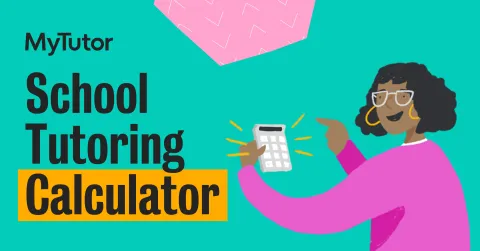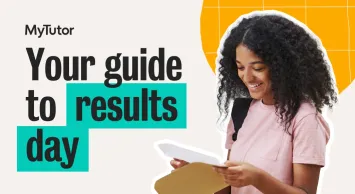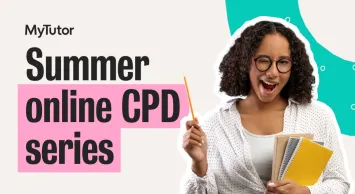Proving the impact of online tutoring: The research you need to know
With new reports regularly published, some landing at over 100 pages long, you’d be forgiven for not keeping up with all the latest research on the education sector.
That’s why we’ve taken 3 recent reports on tutoring and created this handy, easy-to-read summary - so you can get to the key information fast.
Delving into the research from trusted resources Sutton Trust, Education Endowment Foundation, and the National Foundation for Educational Research, this article will give you the low down on the impact and efficacy of tutoring.
With key statistics and advice on what makes tutoring such an effective intervention for schools, as well as analysis of the National Tutoring Programme, we’re here to help you make informed decisions about how best to implement tutoring in your school.
So, let's get started!
‘Tutoring 2023: The New Landscape’, Sutton Trust
First up, Sutton Trust’s report, ‘Tutoring 2023: The New Landscape’, deep dives into recent trends in both private and school-based tutoring.
This report compares the demographic data of both and is full of interesting stats and facts about who is benefitting from tutoring privately and how can schools make the most of this intervention by targeting those that need it most.
Below we summarise the key points you need to know.
Who is accessing private tutoring?
The report provides an interesting breakdown of the current state of play for private tuition today. In terms of the demographics of who is accessing private tutoring currently, there are some interesting points to note:
- Overall, 30% of young people (aged 11-16) report ever having had private tutoring. This is up from 27% pre-pandemic.
- The demographic data shows that: Black and Asian pupils were more than twice as likely to have ever received private tutoring (50% and 55%), compared to White pupils (24%) and 46% of pupils in London had received private tutoring, compared to 30% for England as a whole.
- 18% of all pupils undertook some private tutoring in Year 10 or 11, with wide inequalities in those who were taking it up. 32% of those in the top quarter of incomes had undertaken private tutoring compared to 13% in the bottom.
- Demographic patterns in the uptake of private tutoring and school-based tutoring are very different. In many cases, those using school-based tutoring are the opposite of those using private.
As you can see, private tuition is being disproportionately used by those from higher-income families with wide differences in the demographics of who is receiving tutoring.
The report makes clear that tutoring currently serves to reinforce the advantages of those with existing privileges - something we are keenly aware of here at MyTutor. That’s why we work directly with schools to provide tuition to those who cannot access it at home.
How much impact has the National Tutoring Programme made?
The National Tutoring Programme was established in 2020 and has made a substantial impact on who has access to tuition. The report shows that the NTP has been successful in widening access to tutoring.
Key statistics:
- In 2020, just 10% of secondary school leaders reported that 1:1 and small group tuition was their priority for pupil premium spending that year. By 2022 this was 34%.
- Since the NTP’s inception, nearly 3 million pupils have been able to start a tutoring programme.
The report makes recommendations for how the NTP should be utilised moving forward to continue to maximise its impact. A key one is that the NTP should be seen as a core part of the school system with the focus being on closing the attainment gap for disadvantaged pupils.
What’s the best way to run a tutoring programme?
The Sutton Trust also includes clear, evidence-based recommendations on how to implement effective tutoring programmes in schools. These are:
- Tutoring is more effective in small groups: in fact, evidence shows that 1:1 and small group tuition are some of the most effective strategies to raise attainment.
- Tutoring content should be linked to the wider curriculum and the pupils’ specific needs.
- Programmes should be run with frequent sessions, up to an hour long, for 6-12 weeks to make the most impact.
- Sessions should be run outside of lessons and not within them to make the most impact.
This aligns with our recommendations at MyTutor on how to run an impactful programme, it’s why we offer 1:1 and small group sessions as standard that can be scheduled flexibly around your core timetable.
For more top tips on embedding tutoring in your school check out our blog!
Key quote:
“We simply cannot afford a return to the pre-COVID status quo where tutoring was largely the preserve of families with the most financial resources.” (p.37)
Read the full 39-page report, here.
‘Making a Difference with Effective Tutoring’, Education Endowment Foundation (EEF)
Published last year, the EEF’s research outlines clearly the evidence base for tutoring interventions.
Built on questions and insights gathered from school leaders and teachers nationwide, it outlines the key principles for effective tutoring and recommends that tutoring is an effective intervention for closing the attainment gap.
We highly recommend this report as it’s full of helpful and practical information on how to run your tutoring programmes.
Here we run through some of the highlights.
What are the key principles for effective tutoring?
According to the EEF, there are 3 key principles that make tutoring interventions effective. These are:
1. Selecting pupils and scheduling sessions effectively
2. Aligning tutoring with curriculum and assessment
3. Creating a sustainable tutoring model
Here at MyTutor, we ensure all our programmes meet these 3 principles. We provide advice on pupil selection and schedule lessons flexibly around your timetable. Our tutors are all trained to deliver tuition that aligns with your in-classroom learning and work alongside teachers to fill knowledge gaps. Finally, we help you to embed tutoring in your school in a way that is sustainable.
What kind of tutoring has the most impact?
The EEF makes several recommendations based on research as to what type of tuition programme has the most impact.
It’s found that frequent sessions, which last up to an hour, over 6-12 weeks typically show the greatest impact - this aligns with our core programme!
The report also found that 1:1 tutoring has the greatest impact, although tutoring in small groups may help reduce the potential sense of stigma around tutoring. This is worth bearing in mind if you find your pupils are wary of joining a tutoring programme.
Interestingly, the report shows that once groups reach over 6 or 7 pupils, there’s a noticeable reduction in effectiveness. This is why we run small groups of 3:1 here at MyTutor, to keep group learning as effective as possible.
What advice do they have for implementing effective programmes?
The EEF further makes suggestions on how to implement your programmes. They strongly advise embedding the programme in your school as much as possible, which takes time but is most effective long-term.
There are 2 further tips we recommend from the report:
- Parental engagement: The EEF recommends that fostering parental engagement is consistently shown to improve pupil’s academic outcomes. To maximise impact, investing time into the parent relationship is beneficial.
- Pupil-tutor relationship: Attendance has been shown to be higher for pupils with a strong tutor relationship. Finding common ground at the start of sessions and building rapport creates a positive environment that can improve attendance.
For more recommendations, check out the full report below.
Key quote:
“The research is clear – done well, and aligned to high-quality teaching, tutoring can be hugely successful in accelerating progress for struggling learners. It is also one of the best-evidenced interventions we have to support disadvantaged pupils’ attainment.” Professor Becky Francis, Chief Executive, EEF
Read the full 14-page report for more tips and advice here.
‘Independent Evaluation of the National Tutoring Programme Year 2: Impact Evaluation’, National Foundation for Educational Research (NFER)
The NFER’s annual independent evaluation of the National Tutoring Programme provides a mixed picture of the effectiveness of the NTP in year 2. Following on from the previous year 1 evaluation, the aim is to build on insights into the efficacy of the NTP.
This report looks at impact evaluation across the 3 routes of tutoring for KS2 and KS4 Maths and English. It also evaluates the impact of pupil premium pupils, prior low-attainment pupils, or certain characteristics on overall outcomes.
An important note is that the report itself advises against overanalysing the results due to the complexities of the evaluation. So, essentially, take the research with a pinch of salt!
Below we provide the highlights and help to demystify this complex report.
What are the key takeaways from the NFER’s research?
The top takeaways to note from the report are:
- School-led tutoring (SLT) was seen as the most impactful route:
- As such, 1 month of progress was made in Maths for KS4
- Less than a month was made for KS4 English Language.
- Higher amounts (more hours) of tutoring, were linked to better outcomes overall, particularly for School Led Tutoring.
- Less than half of the pupils selected for tutoring were from disadvantaged backgrounds.
- Tuition Partner routes were often associated with poorer outcomes, but the effects were very small overall and not statistically significant.
- Overall, the report suggests that more evaluation is needed to really understand the long-term impact of tutoring.
While this is not a stellar result, and you may be wondering why we’re including the results here given that we are a Tuition Partner, it’s worth noting that the data presented here has an implicit bias.
We know that the School-Led route is often used by schools to fund tutoring through Tuition Partners due to administrative challenges. This means more schools used SLT funding as it was easier to work with.
At MyTutor, we know that a significant portion of our 21/22 programmes were funded via the SLT route. We agree that more research is needed to fully understand the impact of tutoring through Tuition Partners such as ourselves.
What does the NFER recommend for impactful tutoring?
Once again, what’s most useful in this report for schools is the recommendations for how tutoring can be implemented most effectively in your school. While some of the findings above need further research, there are plenty of recommendations made that are important.
With that in mind, here are the top recommendations the NFER make for making the most of your NTP funding this year:
- More hours means more impact: The impact of tutoring increased with the average number of hours received. It’s recommended that 30 hours over 10 weeks has the greatest impact.
- Shorter courses can still be effective: While 30 hours might work best, it’s also recommended that 12 to 15 hours will have a meaningful impact on pupil attainment.
- Small groups work best: Similar to the other reports we’ve highlighted, it’s recommended that small groups are better aligned with the pupils' needs and make more progress. In fact, small group tuition can result in as much as 2 month’s additional progress.
- Consistency is key: The NFER recommends that in terms of tutor, frequency and duration, it’s important to be consistent and to support your programme with frequent communication from class teachers to embed the programme in your school.
- Find the pupils that will benefit most: Finally, it’s important to focus tuition on those that need it most, for example, pupil premium pupils and students who wouldn’t otherwise have access to tuition.
These findings echo our recommendations here at MyTutor and those from other reports.
While this substantial report provides a mixed picture of the effectiveness of the NTP, there are some key takeaways to note for schools looking to maximise funding this academic year.
For more top tips on the importance of consistent, year-round programmes, check out our blog.
Key quote:
“The NTP set out to ensure that high-quality tutoring would become accessible to pupils most in need of support, not just available to families that could afford it. Alongside expert teaching, the evidence is compelling that tutoring is one of the best bets we have to help narrow the attainment gap.” Nick Brook, CEO of the social mobility charity Speakers for Schools and Chair of the DfE Strategic Tutoring Advisory Group.
The official summary of the report can be found here.
To read the full 108-page report, find it here.
Want to find out more about how to maximise the impact of tutoring in your school? Try our new School Tutoring Calculator for a free, bespoke report that will tell you just that!



